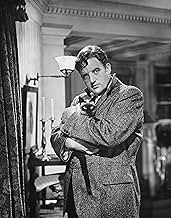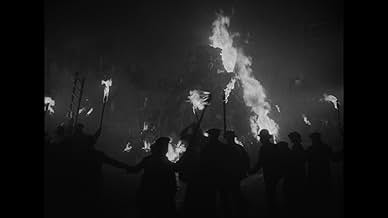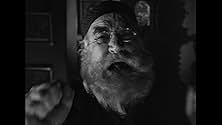AVALIAÇÃO DA IMDb
7,3/10
4,4 mil
SUA AVALIAÇÃO
Adicionar um enredo no seu idiomaA promising classical musician finds his life poisoned by a music hall dancer -- and by the strange gaps in his memory.A promising classical musician finds his life poisoned by a music hall dancer -- and by the strange gaps in his memory.A promising classical musician finds his life poisoned by a music hall dancer -- and by the strange gaps in his memory.
- Direção
- Roteiristas
- Artistas
- Prêmios
- 2 vitórias no total
Harry Allen
- Pot Man
- (não creditado)
Radford Allen
- Boy
- (não creditado)
Jimmy Aubrey
- Drunk
- (não creditado)
J.W. Austin
- Det. Insp. King
- (não creditado)
Brandon Beach
- Concertgoer
- (não creditado)
Wilson Benge
- Waiter
- (não creditado)
Frank Benson
- Newsman
- (não creditado)
Arthur Berkeley
- Pub Patron
- (não creditado)
Ted Billings
- Pub Patron
- (não creditado)
Lulu Mae Bohrman
- Concertgoer
- (não creditado)
Clifford Brooke
- Gas Company Watchman
- (não creditado)
Bob Burns
- Concertgoer
- (não creditado)
- Direção
- Roteiristas
- Elenco e equipe completos
- Produção, bilheteria e muito mais no IMDbPro
Avaliações em destaque
Well worth watching, if you can find it. Cregar is excellent as the concert pianist tortured by obsession with a woman, and what it leads to. Moody, urgent (all the more so in black and white), with mounting suspense and tension. Lush Bernard Hermann score that expresses his anguish. Bonfire scene is gripping.
My parents took me to see this when I was 8 & I had nightmares about it for a month or more - compounded by the knowledge that the lead, the great Laird Cregar died shortly after his appearance in it (of complications from dieting - at age 28!). The total immersion of this film into the clinical madness of a composer who cracks up when he hears discordant sounds & the greed & opportunism of his paramour give it a real nasty Edwardian gothic mood. There are scenes of creepiness here that seem almost the prototypes for Hitchcock classics like Psycho & Vertigo. (Bernard Hermann wrote the composer's scores as well as the background music). But it's also a great exercise on good vs evil, apollo vs dionysius & above all high art vs low art. The 2 main leads, Cregar & Sanders, the director & writer were involved in the making of The Lodger - a Jack the Ripper film - the year before.
Laird Cregar stars as George Harvey Bone, a turn of the 20th century London composer. He's busy working on a concerto, but gets distracted by a chanteuse named Netta Longdon (Linda Darnell). He gets his heart broken by this self-serving lady, who's only interested in what he can do for her. Meanwhile, he keeps suffering prolonged "episodes" - brought on by loud, discordant noises - and he can't remember what he does or where he goes during these periods. As it turns out, he becomes impulsively murderous.
"Hangover Square", named for the London address at which Bone resides, was scripted by Barre Lyndon, based on a novel by Patrick Hamilton. Sadly, it would turn out to be the final picture for Cregar, who suffered the ill effects of an attempted crash diet. But he certainly goes out in style, creating a vivid character who's far more sympathetic than the character he played for director John Brahm in "The Lodger". While the other cast members are good, this largely remains his show - one that his character sees through to the bitter end.
Darnell and the equally lovely Faye Marlowe are intoxicating as the women in his life. One does feel disgruntled on Bones' behalf when Netta reveals her true colours. George Sanders is his typical classy, dapper self as an analyst working for Scotland Yard. Glenn Langan is amusingly smarmy as Bones' rival for Nettas' affections. And Alan Napier, Michael Dyne, and Frederic Worlock lend able support in various other roles.
While the excellent black & white cinematography by Joseph LaShelle is definitely a key element, the film works best as a marriage of image and music. Bernard Herrmann is one of the most valuable assets that the film can boast, as his lush score & concerto provide the perfect accompaniment for these melodramatic goings-on.
One clever highlight: Bone taking advantage of a fiery Guy Fawkes celebration night.
Eight out of 10.
"Hangover Square", named for the London address at which Bone resides, was scripted by Barre Lyndon, based on a novel by Patrick Hamilton. Sadly, it would turn out to be the final picture for Cregar, who suffered the ill effects of an attempted crash diet. But he certainly goes out in style, creating a vivid character who's far more sympathetic than the character he played for director John Brahm in "The Lodger". While the other cast members are good, this largely remains his show - one that his character sees through to the bitter end.
Darnell and the equally lovely Faye Marlowe are intoxicating as the women in his life. One does feel disgruntled on Bones' behalf when Netta reveals her true colours. George Sanders is his typical classy, dapper self as an analyst working for Scotland Yard. Glenn Langan is amusingly smarmy as Bones' rival for Nettas' affections. And Alan Napier, Michael Dyne, and Frederic Worlock lend able support in various other roles.
While the excellent black & white cinematography by Joseph LaShelle is definitely a key element, the film works best as a marriage of image and music. Bernard Herrmann is one of the most valuable assets that the film can boast, as his lush score & concerto provide the perfect accompaniment for these melodramatic goings-on.
One clever highlight: Bone taking advantage of a fiery Guy Fawkes celebration night.
Eight out of 10.
HANGOVER SQUARE was Laird Cregar's last film (he died at 28) and he turns in a fine performance. You can see how haggard he looks from his 100+ pound weight lose which happened before and during the filming of this movie. His appearance and exhaustion fit well with the role of George Bone though. The scene where he carries the body to the Guy Fawkes bonfire and places it with all the mannequins is very memorable as is the ending. The film score by Bernard Hermann is excellent and the concerto Bone "writes" is believable and tense. Cregar even plays the piano very well. It is too bad he died so young after only 5 years making movies as Hollywood lost a fine talent that was just starting out. John Brahms does a good job directing the atmospheric HANGOVER SQUARE too.
Hangover Square is the last film Laird Cregar made in his brief, remarkable career. Freely adapted from Patrick Hamilton's novel, it was directed by John Brahm, photographed by Joseph LaShelle, and features a memorably thunderous score by Bernard Herrmann. Like the previous year's The Lodger, also a Cregar-Brahm collaboration, this is a killer on the loose in Victorian London movie. Aside from some fancily shot scenes early on, this would not in itself be an extraordinary film but for Cregar's portrayal of the lead character, a man who murders when he hears loud, sudden noises. In his quieter moments the man is, of all things, a composer!
There are many fine scenes in this film but it's basically Cregar's show from start to finish, and he does not disappoint. His performance is so brilliant, empathetic, nuanced, and for all the melodrama, utterly believable, that it's impossible not to focus on him at the expense of the rest of the movie.
Perhaps the best way to describe Cregar's acting style here is to imagine A Streetcar Named Desire being performed entirely inside someone's mind, with the characters of Stanley and Blanche being played by the same actor, in a Victorian setting, disguised as a murder story. One wonders where Cregar found the inspiration for such work. He was one of the greatest actors to ever grace the screen, and one of the most enigmatic. American-born, he tended to play Brits. Unlike his fellow American Anglophile actor and friend, Vincent Price, he had no education to speak of. Within a span of less than five years he went from supporting player to star. In this movie he is top-billed over Fox hottie Linda Darnell. Not too shabby for a morbidly obese man several inches over six feet in height who, while still in his twenties, was playing men well into their forties.
Cregar had a way of making even accomplished co-stars like Cedric Hardwicke and George Sanders look like amateurs by comparison. He wasn't even trying to. One should watch his films to see what a great actor is like. His roles weren't always great, but he was. Forget Sean Penn and his tantrums, or Meryl Streep's mannered Yale Drama School flair for accents. Cregar was the real deal. The only American actor I can think of who could give him a run for his money would be Brando. Sadly, Cregar was as tormented as he was gifted, was full of self-hatred, for a variety of reasons, and went on a crash diet after completing this film in the hope of becoming a romantic leading man. But he lost the weight so fast it killed him. He was twenty-eight years old.
There are many fine scenes in this film but it's basically Cregar's show from start to finish, and he does not disappoint. His performance is so brilliant, empathetic, nuanced, and for all the melodrama, utterly believable, that it's impossible not to focus on him at the expense of the rest of the movie.
Perhaps the best way to describe Cregar's acting style here is to imagine A Streetcar Named Desire being performed entirely inside someone's mind, with the characters of Stanley and Blanche being played by the same actor, in a Victorian setting, disguised as a murder story. One wonders where Cregar found the inspiration for such work. He was one of the greatest actors to ever grace the screen, and one of the most enigmatic. American-born, he tended to play Brits. Unlike his fellow American Anglophile actor and friend, Vincent Price, he had no education to speak of. Within a span of less than five years he went from supporting player to star. In this movie he is top-billed over Fox hottie Linda Darnell. Not too shabby for a morbidly obese man several inches over six feet in height who, while still in his twenties, was playing men well into their forties.
Cregar had a way of making even accomplished co-stars like Cedric Hardwicke and George Sanders look like amateurs by comparison. He wasn't even trying to. One should watch his films to see what a great actor is like. His roles weren't always great, but he was. Forget Sean Penn and his tantrums, or Meryl Streep's mannered Yale Drama School flair for accents. Cregar was the real deal. The only American actor I can think of who could give him a run for his money would be Brando. Sadly, Cregar was as tormented as he was gifted, was full of self-hatred, for a variety of reasons, and went on a crash diet after completing this film in the hope of becoming a romantic leading man. But he lost the weight so fast it killed him. He was twenty-eight years old.
Você sabia?
- CuriosidadesIn the book "A Heart at Fire's Center: The Life and Music of Bernard Herrmann," director John Brahm said this about the concerto scene: "For a long time, I had been dissatisfied with the photography of music in films. Musicians themselves are uninteresting; it is what they play that should be photographed. I myself could not read a note of music, but when Herrmann came and saw the finished film he could not believe it. I had photographed his music."
- Erros de gravaçãoThe title of Patrick Hamilton's novel, 'Hangover Square', is a play on words based on 'Hanover Square'. It is not meant to be Bone's actual address as it is in the film version, where a street sign marked 'Hangover Square' is seen.
- Citações
[first title card]
Title Card: This is the story of George Harvey Bone who resided at number 12, Hangover Square, London, S.W. in the early part of the Twentieth Century. The British Catalogue of Music lists him as a Distinguished Composer~~~
- Cenas durante ou pós-créditosOpening credits: This is the story of George Harvey Bone who resided at number 12, Hangover Square, London, S.W. in the early part of the Twentieth Century. The British Catalogue of Music lists him as a Distinguished Composer~~~
- ConexõesFeatured in Biografias: Linda Darnell: Hollywood's Fallen Angel (1999)
- Trilhas sonorasHave You Seen Joe?
(uncredited)
Music by Lionel Newman
Lyrics by Charles Henderson
Performed by Kay St. Germain Wells
[Netta (Linda Darnell) sings the song at the bar hall in her opening performance]
Principais escolhas
Faça login para avaliar e ver a lista de recomendações personalizadas
Detalhes
- Data de lançamento
- País de origem
- Idiomas
- Também conhecido como
- Hangover Square
- Locações de filme
- Empresa de produção
- Consulte mais créditos da empresa na IMDbPro
Bilheteria
- Orçamento
- US$ 1.154.000 (estimativa)
- Tempo de duração1 hora 17 minutos
- Cor
- Proporção
- 1.37 : 1
Contribua para esta página
Sugerir uma alteração ou adicionar conteúdo ausente

Principal brecha
By what name was Concerto Macabro (1945) officially released in India in English?
Responda





























